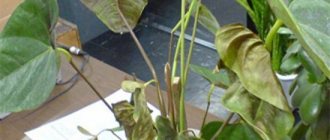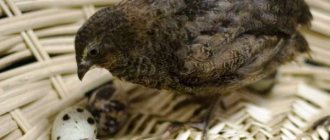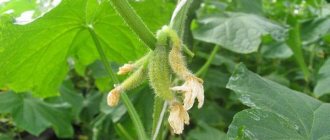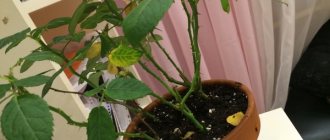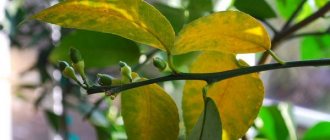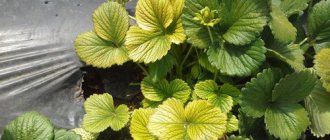Yellow leaves are the first sign that cucumbers are sick.
But before you start dealing with the symptoms, you need to find out the reason for the change in leaf color. And depending on it, select the necessary drugs and carry out the necessary measures. Dear readers!
For you, we have created communities on social networks in which useful articles and interesting ideas are published several times a day! Subscribe and receive useful content in a convenient format! In our article we will talk about why cucumber leaves turn yellow, whether this is always bad, as well as methods for preventing and treating the plant.
Main causes of yellowing
Climatic conditions
Often the color of leaves on cucumber bushes changes due to unfavorable climatic conditions. In this case, the reason may be either too much heat or a sharp temperature change.
Sunburn
In calm weather, direct sunlight overheats the leaf blades and leaves burns on them. This happens especially often if you water cucumbers in the heat and allow drops of water to get on the plant.
Temperature fluctuations also often cause the development of fungal diseases.
Alas, there is no way you can fight nature. But you can help plants survive unfavorable conditions. If a sharp drop in temperature is expected, treat the cucumbers with a growth stimulant or Fitosporin . You can also cover the plantings with spunbond.
Fitosporin
Improper watering
Cucumbers love moisture very much, but they need to be watered carefully following the watering regime.
- Do not use cold tap water.
- It is necessary to water in the morning or evening.
- Water should be poured at the root, trying to avoid moisture getting on the leaves and stems.
IMPORTANT! Try to water the cucumbers regularly and with approximately the same amount of water.
Nutritional deficiencies
So that the cucumbers do not get sick, the leaves are green, and the stems are strong, there must be at least 3 main feedings:
- When 2 true leaves appear.
- At the time when the plant blooms.
- When the fruits begin to set.
Cucumbers prefer liquid complex formulations and mixtures. They are better absorbed by the plant.
Nutritional deficiencies
Experienced gardeners recommend using infusions of weeds or herbal tea as fertilizer during the fruiting period. Such fertilizing has a good effect on fruit set and does not negatively affect the taste of cucumbers.
Excess microelements
An excess of microelements is even more dangerous for cucumbers. Therefore, fertilizing the plant must be carried out exactly following the instructions on the nutrition packaging.
Diseases and pests
Changes in the color of leaf blades are a consequence of pythiosis and fusarium. These are fungal diseases in which dark spots appear first, and only then complete yellowing occurs.
The fungus usually appears after a temperature change. Therefore, for prevention, treat plantings with Fitosporin .
Among the pests, the main enemies of cucumbers are spider mites and whiteflies. These insects feed on plant juices, which causes yellowing and wilting of the foliage. To get rid of pests, use the preparations Fitoverm , Anti-mite , Apollo .
Anti-mite
How to prevent cucumber leaves from turning yellow
To ensure that the cucumbers are strong and healthy, the leaves do not turn yellow and remain green, it is enough to follow simple rules:
- cover plants with film during periods of sharp drop in air temperature;
- do not allow the soil under vegetables to dry out;
- treat the greenhouse, soil, fruits and leaves from pests;
- do not neglect fertilizing;
- do not water the plants in the heat of the day - watering is carried out either early in the morning or in the evening, when the temperature drops and solar activity is minimal.
Why do the lower leaves turn yellow?
Sometimes yellowing leaves are not a sign of a serious disease or micronutrient deficiency. For example, the lowest leaves on bushes may change color for completely natural reasons.
If the plant has a good harvest, then there is nothing wrong with yellowing of the lower leaves. This means that all energy is spent on growth and formation of new fruits. Also, the color of the leaves changes in late summer. But this is a manifestation of the natural aging process of a living organism.
What to do?
First, make sure that your fertilization schedule is being followed. If necessary, feed the plants.
Second, tear off and burn all yellowed leaves. Then treat the bushes with fungicides. You can also use garlic infusion (50 g per 1 liter of water) to fight fungus.
Symptoms and signs
The problem manifests itself through a number of signs, some of which are harbingers of yellowing. If pathology is detected in a timely manner, there is a chance to cope with it.
How does yellowing of cucumbers appear:
- seedling growth is inhibited;
- the stem becomes thinner;
- the color of the plant darkens or turns pale;
- spots of different colors and sizes appear;
- leaves curl, dry out and turn yellow;
- ovaries do not form or they fall off;
- the fruits do not grow, are deformed, have a bitter taste.
When seedlings stop growing, this serves as the main signal to begin combating the problem.
Why do ovaries turn yellow?
Yellowing of ovaries
Changes in the color of ovaries are most often found in those varieties that grow in greenhouses. There are several reasons for this:
- No pinching and formation of bushes has been carried out. The plant develops an excess of green mass. And it turns out that sunlight simply does not reach the ovaries.
- Features of the hybrid. Varieties that produce high yields are not able to provide nutrition to all the ovaries. Therefore, the plant gets rid of some of them. If a small part of the ovaries falls off, then there is nothing to worry about. This is a natural process.
- Pollination does not occur. Usually parthenocarpic hybrids of cucumbers are planted in greenhouses, but sometimes varieties that require pollination are also found.
- Violation of the watering regime and fertilizing schedule. Fertilizers need to be applied to cucumbers every 7 days. During flowering and fruiting, it is necessary to feed with potassium-phosphorus preparations.
- Temperature changes. During the day the greenhouse is very hot, but at night the temperature can drop quite significantly. Because of this difference, the ovaries of cucumbers may turn yellow. To prevent this from happening, close the greenhouse and greenhouse at night. In addition, temperature changes contribute to the appearance of fungus, which also causes the ovaries to turn yellow.
What to do?
Attract pollinating insects. Leave the greenhouse open for a day and spray with sweet water.
In case of potassium deficiency, treat the plantings with Mortar , Kemira or a solution of ash and calcium nitrate (3 tablespoons of ash + 10 g of nitrate per 10 liters of water).
To avoid overheating, mulch the soil under the cucumbers. This technique will also help in the fight against root rot.
If the plant is sick, treat it with Fitosporin and do not forget to tear off and destroy the damaged leaves. This will prevent further spread of the fungus.
If the leaves turn yellow around the edges
A lack of potassium can cause the edges of the leaves to begin to turn yellow, while the leaf itself does not change color. The solution to this problem is easy. You just need to choose a complex fertilizer that contains potassium fertilizers.
You can also use folk remedies:
- Feeding with ash. It contains up to 40% calcium, 12% potassium, 6% phosphorus, a set of microelements, but no chlorine or nitrogen. But it creates favorable conditions in the soil for nitrogen-fixing bacteria. You can simply scatter it around (1 cup per 1 sq. m.) or make a solution for watering (2 tablespoons of ash per liter of water - for one plant).
- Chicken droppings also contain potassium, phosphorus, magnesium and calcium. Dilute 0.5 buckets of manure in 0.5 buckets of water, cover with a lid and let it ferment until gas bubbles stop being released. We dilute the concentrate with water in a ratio of 1:20 and water the cucumbers (1 liter per bush).
Why do leaves turn yellow in open ground?
Cucumbers grown in open ground are exposed to many negative factors. Determining exactly why the leaves turn yellow is quite difficult. This may be due to hypothermia, exposure to direct sunlight, fungal infection, or lack of nutrients.
What to do?
First of all, follow the rules for caring for cucumbers.
- Water with warm water at the root. Cucumbers need to be watered regularly. It is best to do this in the morning or evening.
- Cover plantings during temperature changes. This will protect your plants from hypothermia.
- Carry out regular feeding and preventive treatment against diseases and pests. It is especially important to fertilize during flowering and fruiting.
Cause of yellowing leaves in cucumbers No. 5 and the most dangerous: cucumber diseases
Downy mildew (downy mildew) in cucumbers
The disease is identified by small, numerous pale yellow, yellow-brown spots, which gradually increase in size, turn brown and dry out, as well as by “islands” of white powdery plaque. The disease develops with changes in temperature and high humidity (more often in spring and August-September).
What to do if cucumbers get sick with downy mildew : follow agricultural practices, do not overfeed with nitrogen fertilizers. At the first signs of disease, spray with fungicides or “folk remedies.”
Read more: Prevention and treatment of peronosporosis
Powdery mildew on cucumbers
In this case, a white (or slightly reddish) powdery coating appears on the upper side of the leaf.
signs of powdery mildew on cucumber leaves
What to do if cucumbers get powdery mildew: as in the previous case, it is necessary to follow agricultural practices, and if a disease is detected, spray with fungicides.
Read more: Prevention and treatment of powdery mildew
Root rot in cucumbers
If the leaves of cucumbers gradually wither, wither and dry out, check the roots of the plants - with disease, the root collar turns brown and the roots rot.
What to do if cucumbers have root rot: as a preventive measure, steam the soil, treat the seeds before sowing, do not thicken the plantings, water the plants with warm water. Diseased cucumbers are “rejuvenated”: the stem is bent to the ground, a little fertile soil is poured on top and rooted for 10-15 days.
read more: Prevention and treatment of root rot
Fusarium in cucumbers
The disease is common in greenhouses, especially when there are large temperature changes in the spring. It affects seedlings and adult plants. Before flowering, cucumber plants look healthy, and then, when the ovary appears, they begin to wither. The leaves turn yellow, the stems become thinner, dry out, then the roots die and the whole plant dies.
What to do if cucumbers become ill with fusarium: disinfect the soil in the greenhouse, maintain optimal conditions (temperature, air humidity) and water the plants only with warm water. Severely damaged plants must be destroyed.
Anthracnose in cucumbers
Numerous rounded yellowish (brownish) spots appear on the edges of the leaves and on the stems. The fruits have depressed spots, light brown, wet ulcers.
What to do if cucumbers are sick with anthracnose: carry out the whole range of preventive and therapeutic measures, including pre-sowing treatment of seeds with fungicides, high-quality balanced fertilizing, removal of plant debris and diseased plants. Spray diseased plants with a 1% solution of Bordeaux mixture or 0.5% solution of copper sulfate.
Why do the leaves of cucumbers turn yellow in a greenhouse?
Most often, the leaves of cucumbers growing in greenhouses turn yellow due to improper care:
- The greenhouse is not ventilated.
- Bushes are not formed.
- The plantings are dense.
All this together causes yellowing of the foliage and rotting of the plant’s vines.
Yellowing of cucumber leaves in a greenhouse
What to do?
Ventilation and pinching are two of the most important procedures that will protect your plantings from rot and the development of fungal diseases.
Leaves turn yellow and curl
First of all, take a close look at the back of the leaves. Make sure there are no pests. Leaf curling is one of the main signs of spider mites.
Next, pay attention to whether the plant is affected by fungus. If the leaves are simply yellowed without gray or white spots, then there is no fungus.
What to do?
If signs of a fungal disease or pest are detected, the plantings must be treated with fungicides and insecticides.
IMPORTANT! If affected by the fungus, the infected leaves must be torn off and burned.
The leaf border or edge turns yellow
Yellowing of the leaf edge without the formation of yellow spots on the leaf blade itself indicates a lack of potassium.
Yellowing due to lack of microelements
What to do?
Feed the plant with potash fertilizers. It is best to use liquid preparations with a complex of useful elements.
Why do cucumber seedlings turn yellow?
The reasons for yellowing of seedlings are basically the same as for adult cucumbers. You can add to them too small containers for germination and high humidity in the room.
- Seedlings need space so that the seedlings have sufficiently developed roots to be transplanted into open ground or a greenhouse. If too many plants are germinated in one container, then due to crowding they will gradually begin to turn yellow.
- High humidity in the room causes fungus to appear.
Yellowed cucumber seedlings
What to do?
If the seedlings are crowded, they need to be transplanted into larger containers. But try to select the right size container in advance.
If the air humidity is high, ventilate the room regularly.
IMPORTANT! When ventilating, make sure that your cucumber seedlings are not in a draft. She could easily die from it.
What to do when the leaves of cucumber seedlings turn yellow
Seedlings in general are influenced by the same factors as adult plants. But there are additional reasons:
- Containers that are too tight. When the root system does not have enough space, it cannot develop normally and young plants begin to turn yellow. The best solution in this situation is to transplant the seedlings into larger pots.
- Lack of light. In this case, as a rule, the lower leaves of the seedlings turn yellow (and then die). If the plantings are in a shaded place, then it is better to move them to the window. If this occurs due to the volume of the upper leaves, then the lower wilting ones must be removed in a timely manner.
- Incorrect watering. Watering cucumbers too often or too rarely will cause the leaves to turn yellow.
- High humidity. To avoid fungal diseases, you need to monitor air humidity. The room needs to be ventilated periodically.
- Lack of batteries. In order for the seedlings to be strong and develop well, the first fertilizing (with complex nitrogen fertilizer) should be carried out when the seedlings have 2-4 true leaves.
- Hypothermia. Cucumbers are heat-loving plants and low temperatures negatively affect them. To prevent seedlings from turning yellow, you need to maintain optimal temperature and humidity conditions in the room.
Cucumbers can be fed with organic matter only after planting in the ground.
There are many factors that lead to yellowing of cucumber leaves. Fertilizer deficiency, untimely watering, temperature changes, diseases and pests. But if you properly care for the plant, follow agricultural practices, water and fertilize on time, carry out preventative treatments against pests, you will get an excellent harvest.
Fighting yellowing with folk remedies
You can fight yellowing of cucumber leaves using folk remedies without chemicals.
If the cause of yellowing is a lack of nutrients, then use the following infusion.
Take 300 g of sifted ash, 200 g of dry mullein, mix and fill with a bucket of water. Everything must be thoroughly mixed until smooth and left to infuse for 24 hours. Fertilize at the rate of 1 liter of solution per 1 cucumber bush. The frequency of treatment is 1 time every 7 days.
If the cause of yellowing leaves is infection with fungal diseases or aphid infestation, then use the following recipe.
Wash the affected leaves with a mild soap solution made from laundry soap. Then sprinkle the affected areas with ash. Such treatment should be carried out until the bush is completely healthy at intervals of 3 days.
Another, more powerful remedy is made from natural soda. 1 tbsp. a spoon should be diluted in 5 liters of water. Treat plants using a spray bottle. This product should be used very carefully and only in case of severe infection. Do not under any circumstances exceed the indicated dosage. Otherwise, you will simply “burn” the leaves.
How to treat with drugs?
If folk remedies do not help, then use specialized drugs.
The most effective remedies for yellowing of cucumber leaves are Metronidazole and Fitosporin . Both drugs must be sprayed onto the plant. The proportions for preparing the composition are indicated on the packages. We advise you to follow the instructions so as not to harm the cucumbers even more.
Metronidazole
If yellowing has just begun, then you can try to save the plantings with potassium permanganate. To do this, you need to prepare a 1% solution and spray it on the affected leaves.
If you are sure that the cause of yellowing is a lack of nutrients, feed the bushes with a complex nitrogen-phosphorus-potassium fertilizer.
Prevention
In order to prevent yellowing of leaves, it is recommended to carry out preventive treatments of cucumber plantings.
Solutions based on milk and rye bread are considered the most effective.
Treatment with milk solution
This product protects cucumbers from insect pests and fungus.
The composition is prepared as follows: in 8 liters of water you need to dissolve 0.5 liters of milk (it is advisable to use 2%), 20 g of laundry soap and 20 drops of iodine.
Carry out treatment at intervals of 10 days.
Treatment with solution on rye bread
The product helps against pests and plays the role of additional foliar feeding.
The composition is prepared as follows: 500 g of rye bread is soaked in a bucket of water for 12 hours. Then the soggy crumb must be ground until it turns into a thick, homogeneous mass. After this, 40 drops of iodine are added. The composition is mixed again to a homogeneous consistency. Next, the resulting thick liquid must be filtered to separate the remaining bread from the liquid.
Treatment with the resulting solution should be carried out once every 2 weeks.
How to feed cucumbers if they start to turn yellow
You can feed cucumber bushes:
- Potassium fertilizers: Mortar, Kemira;
- With a lack of nitrogen (the leaves first turn pale and then turn yellow). To spray, you need to dilute 15 grams of carbamide (urea) in 10 liters of water. To feed the root system, dilute 50 grams of urea in 10 liters of water. Make sure that the solution gets into the soil a few centimeters from the root system. During fruiting, it is recommended to reduce the dose or stop using it altogether.
- Can be fertilized with complex nitrogen-phosphorus-potassium fertilizers
- Ash. Dissolve 300 g of wood ash in a bucket of warm water. Water under the roots every week per 1 m² of soil. It is advisable to mulch the top layer of soil with humus in a 2 cm layer.
- Ash + urea for foliar feeding. For a bucket of water, 12 g of urea and 250 g of wood ash. This is enough for 1 m² of cucumber planting. Spray the leaves once every 10 days throughout the growing season. This will promote growth and a large harvest. In the second half of the season, you need to reduce the amount of urea - 5 g of urea and 250 g of wood ash per bucket.
- Boric acid. If it is in short supply, the seedlings grow extremely slowly, the leaves turn yellow, and the crop itself becomes vulnerable. This protects against the appearance of pests and diseases. Dissolve 5 g of boric acid (this is approximately 1 teaspoon) in 3 - 4 liters. hot water. It is important to dissolve well so that the plants do not burn. Pour the resulting solution into a bucket of water. Now you can spray all the leaves. Try to do this evenly.
- Herbal infusion is a universal fertilizer for many plants. Read how to make it and how to feed it here.
- Yeast for productivity and strengthening immunity. It is not recommended to feed yeast feed more than two or three times. For 10 liters of warm water - 2 tbsp. l. sugar, 3 tsp. yeast. Mix and leave for 3 hours. This concentrate should be diluted: take 1 liter of concentrate for 5 liters of water. Used for watering around the root at the rate of 1 liter. on the bush.
- Iodine and brilliant green protect against fungi and rot, increase the level of vitamin C in fruits, and rejuvenate the plant. If you spray cucumbers in a greenhouse or greenhouse, you must subsequently leave the room. Add 10 drops of brilliant green and 3 drops of iodine to a bucket of water. At least 0.5 liters of solution is poured under the plant. If the plants are sick, they are sprayed with a solution: 20 drops of iodine and brilliant green are added to 10 liters of warm water.
- Ammonia is a source of nitrogen. For dull leaf color, yellowness, fragility and fragility of lashes, slow growth and a decrease in the number of flowers, ammonia is used. For spraying 10-15 days after planting in the beds and at the beginning of flowering: 20 ml. alcohol per 10 l. water. 1 liter of solution is poured under the root to prevent nitrogen starvation: 50 ml. alcohol per 10 l. water. In case of mass flowering, the concentration is increased: 90 ml. alcohol per 10 l. water. It is enough to fertilize once a week, but if the cucumbers clearly lack nitrogen, it is permissible to use ammonia every 3-5 days until the balance is restored.
- Fitosporin - developed for cucumbers and saves them from all their diseases. To achieve maximum effect, it is recommended to repeat the treatment several times. If you have powder, then you need to dilute it in warm water in a ratio of 1:2 and let it brew for 2 hours before spraying.
- Metronidazole - treats bacterial and fungal infections. This is an inexpensive drug sold in pharmacies; people are prescribed it for giardiasis. For irrigation, prepare 1 tablet per 1 liter of water; for spraying, dissolve 2 tablets per liter of water.
- Potassium permanganate solution for spraying (3g of potassium permanganate per 10 liters of water). Spray three times every three days. Strengthens the immune system.
- A solution of potassium permanganate and boric acid (5 grams of boric acid and 1.5 grams of potassium permanganate per 10 liters of water). Dissolve boric acid separately in warm water. Such spraying prevents and stops the development of diseases and replenishes the lack of microelements.
- Iodine-soap solution (40 drops of iodine; 20 grams of laundry or tar soap; liter of milk; 10 liters of water). Spray once every 10 days to strengthen the immune system.
If you remove damaged leaves from the bush, the plant will quickly recover.
Waiting for your comments! I really want my efforts to find information to be useful to you and help you care for your plants. Come visit me more often, I will always have useful and interesting articles for you that you can share with your friends on your social networks!

